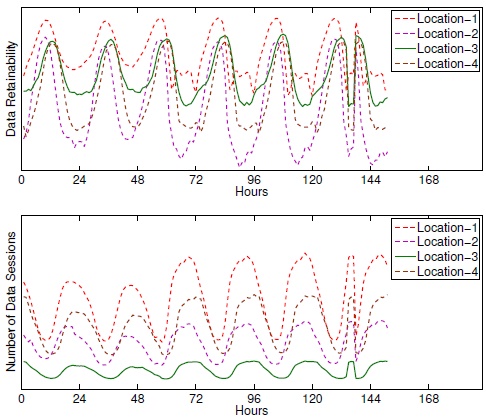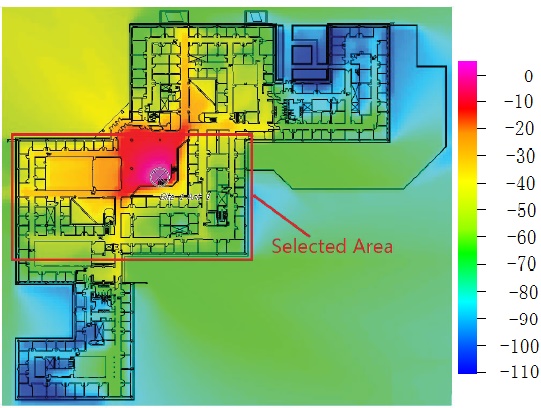Machine Learning for Networking Applications:
Graph Attention Networks for Failure Evaluation and Robust Network Design:
Robust network design, which aims to guarantee network availability under various failure scenarios while optimizing performance/cost objectives, has received significant attention. Existing approaches often rely on model-based mixed-integer optimization that is hard to scale or employ deep learning to solve specific engineering problems yet with limited generalizability. In this direction, we show that failure evaluation provides a common kernel to improve the tractability and scalability of existing solutions. By providing a neural network function approximation of this common kernel using graph attention networks, we develop a unified learning-based framework, FERN, for scalable Failure Evaluation and Robust Network design. FERN represents rich problem inputs as a graph and captures both local and global views by attentively performing feature extraction from the graph. It enables a broad range of robust network design problems, including robust network validation, network upgrade optimization, and fault-tolerant traffic engineering, to be recasted with respect to the common kernel and thus computed efficiently using neural networks and over a small set of critical failure scenarios.
- Chenyi Liu, Vaneet Aggarwal, Tian Lan, Nan Geng, Yuan Yang, Mingwei Xu, and Qing Li,"FERN: Leveraging Graph Attention Networks for Failure Evaluation and Robust Network Design," Accepted to IEEE/ACM Transactions on Networking, Aug 2023.
- Chenyi Liu, Vaneet Aggarwal, Tian Lan, Nan Geng, Yuan Yang, and Mingwei Xu, "Machine Learning for Robust Network Design: A New Perspective," IEEE Communications Magazine, IEEE Communications Magazine, vol. 61, no. 10, pp. 86-92, October 2023.
Reinforcement Learning for Network Resource Allocation:
Reinforcement Learning has been increasingly used for efficient resource allocation. However, there are multiple challenges in networking applications that make the reinforcement learning tools not applicable. Some examples include multiple agents where the fairness objective causes non-linearity, scaling to large networks leads to efficient solutions splitting the network, constraints in decision making, etc. In this theme, we propose novel algorithms to take these aspects into account for efficient algorithms for traffic engineering, power control, and caching decisions.
- Chang-Lin Chen, Hanhan Zhou, Jiayu Chen, Mohammad Pedramfar, Vaneet Aggarwal, Tian Lan, Zheqing Zhu, Chi Zhou, Tim Gasser, Pol Mauri Ruiz, Vijay Menon, Neeraj Kumar, and Hongbo Dong, Two-tiered Online Optimization of Region-wide Datacenter Resource Allocation via Deep Reinforcement Learning," Jun 2023.
- Nan Geng, Qinbo Bai, Chenyi Liu, Tian Lan, Vaneet Aggarwal, Yuan Yang, and Mingwei Xu, "A Reinforcement Learning Framework for Vehicular Network Routing Under Peak and Average Constraints," IEEE Transactions on Vehicular Technology (TVT), vol. 72, no. 5, pp. 6753-6764, May 2023.
- Chenyi Liu, Nan Geng, Vaneet Aggarwal, Tian Lan, Yuan Yang and Mingwei Xu, "CMIX: Deep Multi-agent Reinforcement Learning with Peak and Average Constraints," in Proc. ECML, Sep 2021 (21% acceptance rate, 147/685).
- Nan Geng, Tian Lan, Vaneet Aggarwal, Yuan Yang, and Mingwei Xu, "A Multi-agent Reinforcement Learning Perspective on Distributed Traffic Engineering," in Proc. IEEE International Conference on Network Protocols (ICNP), Oct 2020. (16.8% acceptance rate, 31/184).
- Yimeng Wang, Yongbo Li, Tian Lan, and Vaneet Aggarwal, "DeepChunk: Deep Q-Learning for Chunk-based Caching in Data Processing Networks," IEEE Transactions on Cognitive Communications and Networking, Special Issue on Deep Reinforcement Learning for Future Wireless Communication Networks, vol. 5, no. 4, pp. 1034-1045, Dec. 2019.
- Ramkumar Raghu, Pratheek Upadhyaya, Mahadesh Panju, Vaneet Aggarwal, and Vinod Sharma, "Deep Reinforcement Learning Based Power control for Wireless Multicast Systems," in Proc. Allerton, Oct 2019.
- Yimeng Wang, Yongbo Li, Vaneet Aggarwal, and Tian Lan, "Deep Q-Learning for Chunk-based Caching in Data Processing Networks," in Proc. Allerton, Oct 2019.
Applications of Exploiting Data Structure in Matrix/Tensor for Better Sampling, Fingerprinting, and Estimation:


Exploiting structure in the data across multiple dimensions can lead to efficient techniques for efficient sampling and fingerprinting. The figure alongside shows different network service atributes dependence on time, spatial locations and data service quality measurements thus motivating tensor structure. Further, the map shows the received signal strength in indoor has spatial dependence and the signals from different APs are correlated and thus adaptive sampling can reduce fingerprints needed for localization.
- X. Liu, S. Aeron, V. Aggarwal, and X. Wang, "Low-tubal-rank Tensor Completion using Alternating Minimization," IEEE Transactions on Information Theory, vol. 66, no. 3, pp. 1714-1737, March 2020.
- W. Wang, Y. Sun, B. Eriksson, W. Wang, and V. Aggarwal, "Wide Compression: Tensor Ring Nets," in Proc. CVPR, Jun 2018
- W.Wang, V. Aggarwal, and S. Aeron, "Efficient Low Rank Tensor Ring Completion," in Proc. ICCV, Oct 2017.
- W.Wang, V. Aggarwal, and S. Aeron, "Unsupervised Clustering Under The Union of Polyhedral Cones (UOPC) Model," Pattern Recognition Letters, vol. 100, pp. 104-109, Dec 2017.
- V. Aggarwal, A. A. Mahimkar, H. Ma, Z. Zhang, S. Aeron, and W. Willinger, "Inferring Smartphone Service Quality using Tensor Methods," in Proc. 12th International Conference on Network and Service Management Oct-Nov, 2016.
- X. Liu, S. Aeron, V. Aggarwal, X. Wang, and M. Wu, "Adaptive Sampling of RF fingerprints for Fine-grained Indoor Localization," IEEE Transactions on Mobile Computing, vol. 15, no. 10, pp. 2411-2423, Oct. 2016.
- X. Liu, S. Aeron, V. Aggarwal, and X. Wang, "Low-tubal-rank Tensor Completion using Alternating Minimization," in Proc. SPIE Defense + Security, 2016.
- X. Liu, S. Aeron, V. Aggarwal, X. Wang, and M. Wu, "Tensor completion via adaptive sampling of tensor fibers: An application to efficient RF fingerprinting," in Proc. IEEE ICASSP, Mar 2016.
Exploiting Network Structure for Better Scheduling Strategies:

Learning the network characteristics is crucial for coming up with next generation network designs. Getting the measurements of the received power from a tower leads to path loss which helps in design of efficient codes. Fingerprinting roads can help find efficient scheduling/handoff decisions for a service provider. Learning attributes at the network helps learn interaction between different layers to achieve better designs. The distribution of interference can lead to better interference management techniques. This understanding will be useful to achieve new and better system designs. The figure alongside depicts a mobile user trajectory along a road through 3 cellular sectors showing interactions with the cellular network and the measured values of channel quality (Ec/Io) during 3 different drives. This structure has been used to novel scheduling strategies with prediction.
- R. Margolies, A. Sridharan, V. Aggarwal, R. Jana, N. K. Shankaranayanan, V. Vaishampayan, and G. Zussman, "Exploiting Mobility in Proportional Fair Cellular Scheduling: Measurements and Algorithms," IEEE/ACM Transactions on Networking, vol. 24, no. 1, pp. 355-367, Feb. 2016.
- R. Margolies, A. Sridharan, V. Aggarwal, R. Jana, N. K. Shankaranayanan, V. Vaishampayan, and G. Zussman, "Exploiting Mobility in Proportional Fair Cellular Scheduling: Measurements and Algorithms," in Proc. Infocomm 2014.
- V. Aggarwal, R. Jana, J. Pang, K. K. Ramakrishnan and N. K. Shankaranarayanan, "Characterizing Fairness for 3G Wireless Networks," in Proc. LANMAN, Oct. 2011.
- V. Aggarwal and S. Krishnan, "Achieving Approximate Soft Clustering in Data Streams," 2011. Implementation
Modeling Application QoE from Passive Network Measurements:

Video and web applications are the most prominent applications in today's world. It is important to understand how radio network characteristics (such as signal strength, handovers, load, etc.) influence users' Quality-of-Experience (QoE). Understanding the relationship between QoE and network characteristics is a pre-requisite for cellular network operators to detect when and where degraded network conditions actually impact QoE. Unfortunately, cellular network operators do not have access to detailed server-side or client-side logs to directly measure QoE metrics, such as abandonment rate, stalls, and video/session length. We devise a machine-learning-based mechanism to infer web QoE metrics from network traces accurately. The image alongside depicts partial web downloads as a function of network attributes.
- A. Balachandran, V. Aggarwal, E. Halepovic, J. Pang, S. Seshan, S. Venkataraman, and H. Yan "Modeling Web Quality-of-Experience on Cellular Networks," in Proc. Mobicom 2014
- V. Aggarwal, E. Halepovic, J. Pang, S. Venkataraman, and H. Yan "Prometheus: Toward Quality-of-Experience Estimation for Mobile Apps from Passive Network Measurements," in Proc. Hotmobile 2014
- V. Ramaswami, K. Jain, R. Jana, and V. Aggarwal, "Modeling Heavy-tails in Traffic Sources for Network Performance Evaluation," in Proc. International Conference on Computational Intelligence, Cyber Security and Computational Models, Dec. 2013.
Home





